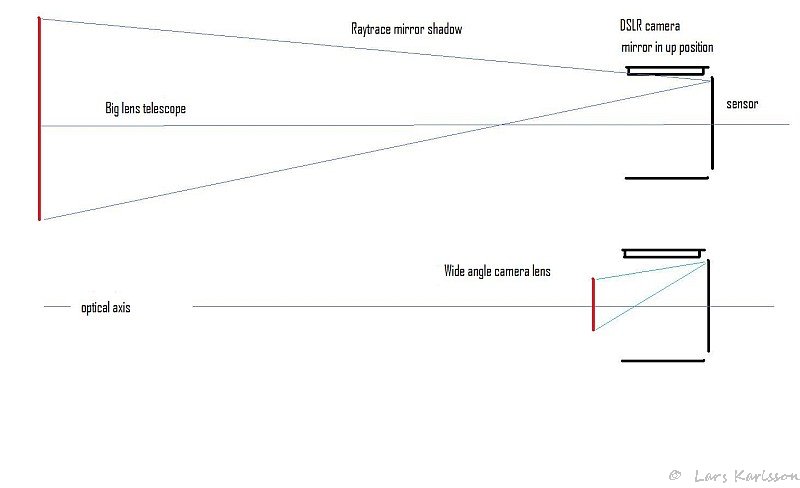|
Advertisement / Annons: |
My astronomy project:
|
Content:
|
6: Why do we get vignetting from the DSLR camera house?How it come that the mirror in a DSLR camera can block the marginal rays of the light cone, it can not be seen with ordinary camera lenses? 
DSLR camera mirror must sit very close to the sensor to let the viewfinder to see the whole sensor when the mirror is folded down, 98% of the field is normal. If you put it further away then it causes to have a larger mirror and then the distance between the mount (optic) and the sensor is increased. It's not practical to increases the size of the camera body, larger mirror also becomes slower. Study the ray trace above I made. Telescope-like optics with big opening gives a large diameter on the incident cone of light towards the sensor. Seen quite clearly in the picture what is happening. In my case with the Canon 5D it looks like 30% of the light cone at the edge is blocked by the mirror of the light ray that's directed to the sensor edge. Canon has a fairly large opening in the bayonet, 54mm, bigger than most other DSLR cameras. For a normal camera lens the light cone is not that big and nothing like this phenomenon occurs. A little rough estimate, maybe you can appreciate that when the rear lens element exceeds 30mm and at full aperture, this should be a problem. Mirror less cameras for example. Sony A7 would solve this problem if just the camera body entrance had been large enough, now, unfortunately, Sony bayonet have only 46mm free opening, but the back focus is short, only 18mm. Off-axis adapter causes a similar problem, it is placed further out from the camera, the distance is about 50mm from the sensor. The pickup prism sits normally along sensor's long side and the sensor on a full frame is 24mm in height. The edge of the sensor is thus 12mm from the optical center. But at a distance of 50mm the light ray cone diameter is quite large.
Example: It gives a diameter of the optics of 200mm. Close to the sensor the light cone is almost 0 mm in diameter. At 50mm spacing is 50/1000 * 200 = 10mm. The center of the cone of light will also slightly closer to the optical axis, 2.2mm. We do not monitor the center, it's the edges that's important. The sensor height is 12mm outward from the optical axis is calculated. The distance to the off-axis adapter prism must therefore be at least (24 + 10-2.2) /2=15.9mm out from the optical center. All that is in the way in a radius of 16mm will block light rays. Unfortunately prism of normal off-axis guiders are in this area. In the other direction the sensor is 36mm, it gives a radius of 22mm must be free. I have set up an excel sheet to calculate this. There is a limit how far away we can put the prism from the optical axis, optics image circle will set a limit even if the mechanics would allow it. The light must come into the off-axis pickup-prism, if the image circle is too small on the optics then the off-axis field is dark at greater distances. With a shorter focal length and a less opening problem it becomes easier to solve. Or an APS-H sensor camera.
|
|